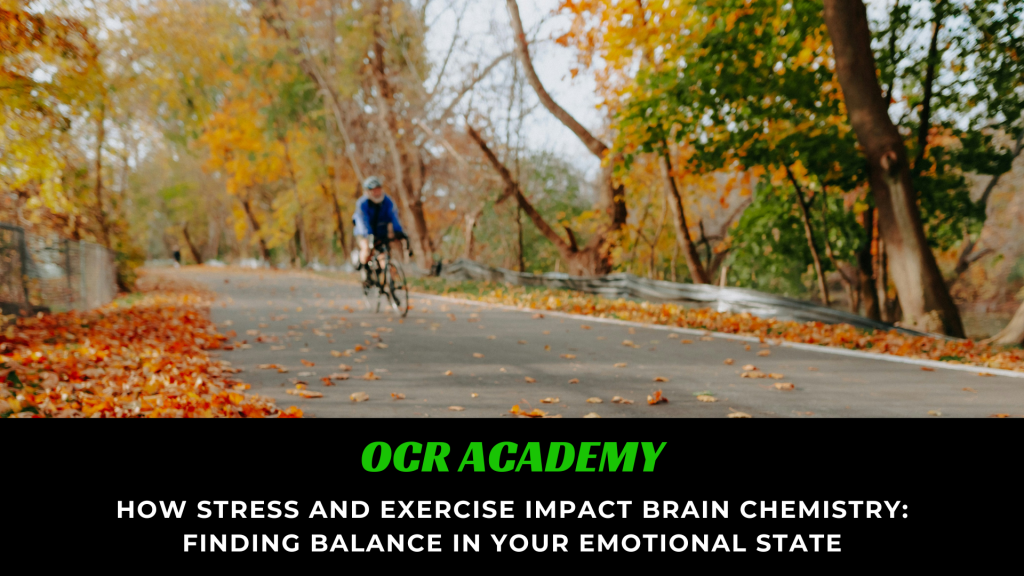Life is filled with highs and lows, and our emotional reactions to these experiences are often accompanied by a powerful cocktail of chemicals released from our brains. When we face stress—whether it’s a heated argument, a tough day at work, or a sudden, painful loss—our brain releases cortisol and adrenaline, hormones that prepare our body for a fight-or-flight response. However, these same stress hormones can sometimes be released during exercise, especially if we approach it aggressively while emotionally charged. Understanding how our brain chemistry works during stress and exercise can guide us in finding ways to manage our emotions constructively, ensuring exercise remains a healthy outlet rather than fueling our stress.
The Chemical Responses to Stress
When we encounter stressful situations, our brain activates the hypothalamic-pituitary-adrenal (HPA) axis, triggering the release of cortisol and adrenaline. These hormones are designed to help us respond quickly to threats by raising our heart rate, increasing alertness, and preparing muscles for action. However, when released repeatedly due to ongoing stress, they can leave us feeling anxious, drained, and even impact our immune function and overall health.
Take, for instance, getting into an argument with a close friend. The disagreement could evoke feelings of anger, frustration, and hurt. Emotionally, you may replay the event, escalating stress levels even further. This could also happen in the workplace with a colleague, where frustration, impatience, and unresolved emotions might build. In these cases, our brain shifts into survival mode, fueling a state that is on high alert for danger, real or imagined.
Similarly, the grief and sadness associated with the sudden loss of a loved one can evoke a deep emotional and chemical response. In these moments, the flood of stress hormones creates a heightened state that is challenging to shake off. Dr. Gabor Maté, a physician and author known for his work on trauma and addiction, explains that chronic exposure to stress can lead to long-term changes in our brain’s stress response, contributing to mental and physical health struggles.
Exercise and Its Chemical Response
On the flip side, exercise is known to be one of the most effective ways to boost mood and release “feel-good” chemicals, like endorphins and dopamine. Dr. Joe Dispenza, in his work on the brain and behavior, discusses how physical activity can rewire our brain to support positive emotional states and break patterns of stress-related reactions. However, timing and intensity matter, especially when we’re already in a heightened state of stress.
Imagine walking into a workout immediately after that argument with your friend or after dealing with a difficult, emotionally charged situation at work. Your heart is still racing from the stress, cortisol and adrenaline levels are already elevated, and adding intense exercise could signal to your brain that the “threat” hasn’t subsided. Essentially, your brain might interpret the combined stress and exercise response as a survival situation, amplifying fight-or-flight signals rather than calming them down.
In such moments, exercise may feel like you’re pushing against your own body’s resistance, turning an activity meant for relief into a further source of agitation. As Dale Carnegie, author of How to Win Friends and Influence People, noted, cultivating calm and groundedness is crucial, especially in emotionally charged moments. Pushing too hard could lead to burnout rather than relief.
Finding a Balance: Calming the Mind, Elevating the Mood
To ensure exercise remains a source of relief and positive energy, it’s essential to “reset” your emotional state before diving into a workout, especially if you’ve been emotionally triggered. Here’s a few strategies to consider:
1. Start with Deep Breathing or Meditation: Before exercising, spend 5-10 m th inutes focusing on slow, deep breaths. Deep breathing helps activate the parasympathetic nervous system, which can reduce cortisol and adrenaline levels. Dr. Dispenza discusses how practicing mindfulness and meditation before exercise can “set the stage” for a more balanced, fulfilling experience.
2. Choose the Right Intensity: If you’re emotionally charged, it might be better to choose a low- to moderate-intensity workout, like walking, yoga, or swimming. These forms of exercise can help release endorphins and dopamine without triggering a fight-or-flight response. Save high-intensity workouts for when your baseline stress level is lower.
3. Visualize a Positive Outcome: Dr. Dispenza talks about the power of visualization. Visualize how you want to feel after your workout. Envision yourself releasing tension and feeling calm, centered, and refreshed. By intentionally focusing on a positive outcome, you can help shift your body’s chemical response to align with that vision.
4. Engage in Meaningful Social Connections: Sometimes, exercise in a social setting, like joining a group class or taking a walk with a friend, can help offset feelings of isolation that may accompany stress. Research shows that social support releases oxytocin, a hormone that counteracts the effects of cortisol, creating a more balanced emotional state.
5. Practice Gratitude: Take a moment after exercising to focus on something you’re grateful for, even if it’s as simple as the ability to move your body. This shift in focus can help elevate serotonin levels, promoting a sense of peace and happiness.
The Benefits of Cultivating Feel-Good Chemicals
When you’re able to shift your state from stress to calm, you’re inviting your brain to release more feel-good chemicals—endorphins, dopamine, oxytocin, and serotonin. Not only do these hormones improve mood, but they also support resilience, motivation, and our overall sense of well-being. Dr. Joe Dispenza explains that by making a habit of “feeling better” through intentional practices, we can retrain our brain to respond to life’s challenges from a more empowered, less reactive place.
Similarly, Gabor Maté emphasizes the importance of self-compassion and understanding in managing stress responses. Recognizing and honoring your emotional needs, whether by taking a gentler approach to exercise or stepping back to reset, helps you move from survival mode into a space where healing and growth are possible.
Conclusion
In a world where stress is unavoidable, our relationship with exercise—and how we approach it during challenging times—can make all the difference. Exercise is an invaluable tool for managing stress, but only when used in a way that aligns with our emotional needs. By pausing to reset, embracing gentler forms of exercise when stressed, and cultivating feel-good chemicals through mindfulness and intentionality, we empower ourselves to live not in a state of reactivity, but in a state of resilience and well-being.



